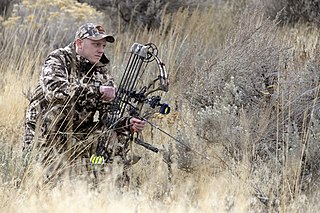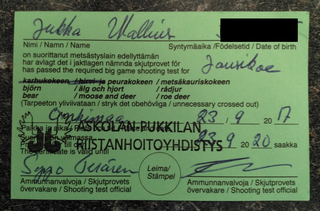
Hunting is the human practice of seeking, pursuing, capturing, or killing wildlife or feral animals. The most common reasons for humans to hunt are to exploit the animal's body for meat and useful animal products, for recreation/taxidermy, although it may also be done for non-exploitative reasons such as removing predators dangerous to humans or domestic animals, to eliminate pests and nuisance animals that damage crops/livestock/poultry or spread diseases, for trade/tourism, or for ecological conservation against overpopulation and invasive species.

Poaching is the illegal hunting or capturing of wild animals, usually associated with land use rights. Poaching was once performed by impoverished peasants for subsistence purposes and to supplement meager diets. It was set against the hunting privileges of nobility and territorial rulers.

In Africa, the Big five game animals are the lion, leopard, rhinoceros, elephant, and African buffalo. The term was coined by big-game hunters to refer to the five most difficult animals in Africa to hunt on foot, but is now more widely used by game viewing tourists and safari tour operators. They are examples of charismatic megafauna, featuring prominently in popular culture, and are among the most famous of Africa's large animals.

A game reserve is a large area of land where wild animals live safely or are hunted in a controlled way for sport. If hunting is prohibited, a game reserve may be considered a nature reserve; however, the focus of a game reserve is specifically the animals (fauna), whereas a nature reserve is also, if not equally, concerned with all aspects of native biota of the area.
A canned hunt is a trophy hunt which is not "fair chase", typically by having game animals kept in a confined area such as in a fenced ranch to prevent the animals' escape and make tracking easier for the hunter, in order to increase the likelihood of the hunter obtaining a kill. The term has been used for driven grouse shooting, in which large areas of Britain are farmed for red grouse. According to WordNet, a canned hunt is a "hunt for animals that have been raised on game ranches until they are mature enough to be killed for trophy collections."

Trophy hunting is a form of hunting for sport in which parts of the hunted wild animals are kept and displayed as trophies. The animal being targeted, known as the "game", is typically a mature male specimen from a popular species of collectable interests, usually of large sizes, holding impressive horns, antlers, furs or manes. Most trophies consist of only select parts of the animal, which are prepared for display by a taxidermist. The parts most commonly kept vary by species, but often include head, hide, tusks, horns, or antlers.

Bowhunting is the practice of hunting game animals by archery. Many indigenous peoples have employed the technique as their primary hunting method for thousands of years, and it has survived into contemporary use for sport and hunting.
Hunting strategy or hunting method is any specific techniques or tactics that are used to target, pursue, and hunt an animal. The term mostly applies to humans catching and killing wild animals, but can also be used in ethology and nature documentaries to describe predation strategies adopted by carnivores.

Cabela's Big Game Hunter 2005 Adventures is a 2004 hunting video game published by Activision Value for Microsoft Windows, Xbox, GameCube, PlayStation 2, and Game Boy Advance. It is also a backwards-compatible title for the Xbox 360. It is the first story-driven hunting adventure game.

Safari Club International (SCI) is a US organization composed of hunters dedicated to protecting the freedom to hunt. SCI has more than 50,000 members and 180 local chapters. SCI members agree to abide by the organization's code of ethics, which includes making a positive contribution to wildlife and ecosystems, complying with game laws, and assisting game and fish officers.

Deer hunting is hunting deer for meat and sport, an activity which dates back tens of thousands of years. Venison, the name for deer meat, is a nutritious and natural food source of animal protein that can be obtained through deer hunting. There are many different types of deer around the world that are hunted for their meat. For sport, often hunters try to kill deer with the largest and most antlers to score them using inches. There are two different categories of antlers. They are typical and nontypical. They measure tine length, beam length, and beam mass by each tine. They will add all these measurements up to get a score. This score is the score without deductions. Deductions occur when the opposite tine is not the same length as it is opposite. That score is the deducted score.

A hunting license or hunting permit is a regulatory or legal mechanism to control hunting, both commercial and recreational. A license specifically made for recreational hunting is sometimes called a game license.

Cabela's Big Game Hunter: 2004 Season is the sixth sequel to the original Cabela's Big Game Hunter. It was developed by Sand Grain Studios and released on August 26, 2003. The game was published by Activision Value, in conjunction with hunting supply company Cabela's.

Lion hunting is the act of hunting lions. Lions have been hunted since antiquity.
Romania has a long history of hunting and remains a remarkable hunting destination, drawing many hunters because of its large numbers of brown bears, wolves, wild boars, red deer, and chamois. The concentration of brown bears in the Carpathian Mountains of central Romania is largest in the world and contains half of all Europe's population, except Russia.

A professional hunter is a person who hunts and/or manages game by profession. Some professional hunters work in the private sector or for government agencies and manage species that are considered overabundant, others are self-employed and make a living by selling hides and meat, while still others guide clients on big-game hunts.

Cecil was a male African lion who lived primarily in the Hwange National Park in Matabeleland North, Zimbabwe. He was being studied and tracked by a research team of the University of Oxford as part of a long-term study.

Green hunting is the practice of tracking and shooting game animals with non-lethal tranquilizer guns or bows and subsequently releasing the captured animals alive. Green hunting would typically be performed when tranquilization of the animal is necessary for veterinary, monitoring or species translocation purposes.
Olivia Nalos Opre is a conservation enthusiast and 2003 Mrs. Nebraska and Mrs. America contestant who lives in Montana.




















